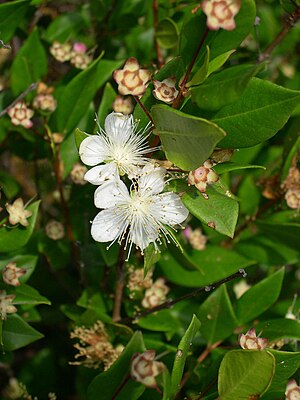Note: This is a project under development. The articles on this wiki are just being initiated and broadly incomplete. You can Help creating new pages.
Myrtus communis
Myrtus communis is also known as common myrtle or true myrtle. It is a species of flowering plant in the myrtle family Myrtaceae. It is an evergreen shrub native to southern Europe, north Africa, western Asia, Macaronesia and the Indian Subcontinent.
Contents
[hide]- 1 Uses
- 2 Parts Used
- 3 Chemical Composition
- 4 Common names
- 5 Properties
- 6 Habit
- 7 Identification
- 8 List of Ayurvedic medicine in which the herb is used
- 9 Where to get the saplings
- 10 Mode of Propagation
- 11 How to plant/cultivate
- 12 Commonly seen growing in areas
- 13 Photo Gallery
- 14 References
- 15 External Links
Uses
Gastric ulcer, Diarrhea, Dysentery,Cancer, Rheumatism, Hemorrhage, Deep sinuses, Leucorrhoea, Hemorrhoid, Inflammation, Dyspepsia, Anxiety, Insomnia, Diabetes
Parts Used
Chemical Composition
Linalool (36.2%), followed by estragole (18.4%) and 1,8-cineole (11.4%). The oxygenated monoterpenes were the predominant chemical group (71.2%), followed by the sesquiterpenoids (16%).[1]
Common names
| Language | Common name |
|---|---|
| Kannada | Murukulu gida |
| Hindi | Baragasha, Murad, Vilayati mehndi |
| Malayalam | |
| Tamil | Cativam, Kulinaval |
| Telugu | Chitti jama |
| Marathi | NA |
| Gujarathi | NA |
| Punjabi | NA |
| Kashmiri | NA |
| Sanskrit | गGandhamalati |
| English | True Myrtle, Common myrtle |
Properties
Reference: Dravya - Substance, Rasa - Taste, Guna - Qualities, Veerya - Potency, Vipaka - Post-digesion effect, Karma - Pharmacological activity, Prabhava - Therepeutics.
Dravya
Rasa
Guna
Veerya
Vipaka
Karma
Prabhava
Habit
Identification
Leaf
| Kind | Shape | Feature |
|---|---|---|
| Simple | Round in outline | The leaf is entire, 3-5 cm long, producing a fragrant essential oil. |
Flower
| Type | Size | Color and composition | Stamen | More information |
|---|---|---|---|---|
| Bisexual | Star-like flowers | White | The flowers are pollinated by insects, and the seeds are dispersed by birds that eat the berries. |
Other features
List of Ayurvedic medicine in which the herb is used
Where to get the saplings
Mode of Propagation
How to plant/cultivate
When fully dormant Myrtus communis is hardy to between -10 and -15°C (14-5°F) as long as it is sheltered from cold drying winds, though it does withstand quite considerable maritime exposure.[3]
Commonly seen growing in areas
Photo Gallery
References
External Links
- Ayurvedic Herbs known to be helpful to treat Gastric ulcer
- Ayurvedic Herbs known to be helpful to treat Diarrhea
- Ayurvedic Herbs known to be helpful to treat Dysentery
- Ayurvedic Herbs known to be helpful to treat Cancer
- Ayurvedic Herbs known to be helpful to treat Rheumatism
- Ayurvedic Herbs known to be helpful to treat Hemorrhage
- Ayurvedic Herbs known to be helpful to treat Deep sinuses
- Ayurvedic Herbs known to be helpful to treat Leucorrhoea
- Ayurvedic Herbs known to be helpful to treat Hemorrhoid
- Ayurvedic Herbs known to be helpful to treat Inflammation
- Ayurvedic Herbs known to be helpful to treat Dyspepsia
- Ayurvedic Herbs known to be helpful to treat Anxiety
- Ayurvedic Herbs known to be helpful to treat Insomnia
- Ayurvedic Herbs known to be helpful to treat Diabetes
- Herbs with Leaves used in medicine
- Herbs with common name in Kannada
- Herbs with common name in Hindi
- Herbs with common name in Tamil
- Herbs with common name in Telugu
- Herbs with common name in Sanskrit
- Herbs with common name in English
- Habit - Herbs
- Index of Plants which can be propagated by Seeds
- Herbs that are commonly seen in the region of Garden area
- Herbs
- Myrtaceae




